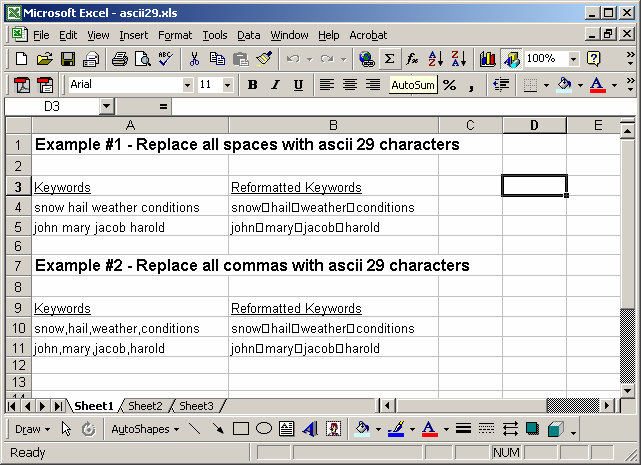
- #Excel for mac ascii code 160 how to#
- #Excel for mac ascii code 160 portable#
- #Excel for mac ascii code 160 pro#
- #Excel for mac ascii code 160 plus#
(please note, the example above will work if you copy/paste.
:max_bytes(150000):strip_icc()/Excelvalues-5a21b696f2ab4eb69147d68e9d127bba.jpg)
#Excel for mac ascii code 160 how to#
The one problem I am having now is figuring out how to remove the spacial spaces (I thought it was called white space but it seems not the case) after the numbers or text. I copy and paste large lists from ms access 2003 database into excel daily so I can do various functions to the lists.
#Excel for mac ascii code 160 pro#
Maybe some Office Watch reader can remember the reason from the early days of personal computing? Let us know via our Feedback page.I am using Office 2003 under windows XP Pro Why the Alt + code number only works with the number pad? We don’t know, it’s always been that way. While the characters produced by the top row keys and number pad keys are the same, the underlying keystroke ‘scan codes’ are different.įor example, pressing ‘3’ on the top row sends code 26 from the keyboard to Windows while ‘3’ on the number pad sends code 7A. This trick doesn’t work in Outlook, Excel or Powerpoint but you can paste text from Word into those programs – as long as you use the same font.Īfter all they are the same characters, surely it doesn’t matter which key you press? In Word there’s an easier way, just type in the Unicode number (top row keys are OK) then Alt+X and the value will be converted to the character. We found the character and code number from the Insert Symbol dialog, choosing the correct font and selecting Unicode (hex) values. Hold down Alt while pressing +2601 will display a cloud symbol if the Arial Unicode MS font is set. To enter a hex value hold down the Alt key then press the + sign on the number pad followed by the Unicode number. This will let you enter hexadecimal values via the number pad. Give the key a REG_SZ value of 1 then restart the system Go into RegEdit and find or make the key HKCUControl PanelInput MethodEnableHexNumpad We absolutely do NOT recommend this (there are better ways to enter characters) but mention it for the sake of completeness: If you want an Alt + number shortcut to enter a Unicode character you need to change Windows via the registry. Unicode is the modern replacement for code pages with over 109,000 characters possible in a single font, though few fonts are that comprehensive except ‘Arial Unicode MS’ supplied with Windows. As you can see they are all different depending on whether you enter the leading zero or not. If you type a leading zero on the number (eg Alt + 064 ) then you’ll see the character according to the current Windows code page setting (usually Windows-1252 for any computer using the Latin alphabet).įor the low value number codes, the DOS compatibility and Windows code character are the same (as with Alt + 64 and Alt + 064), but when you get into the higher numbers, above 127, the characters can change.Īs an example, here are the characters for 160 to 169. When you enter an Alt + number without a zero at the start, you’re telling Windows to use the DOS compatibility characters. As usual in Windows, something that appears simple gets more complicated as you dig into it. Find the character you want, select ASCII (decimal) and read the decimal code.Īs you can see, the upper and lower case versions of an accented character are 32 numbers apart.įor most people the simple Alt + a code number is enough. 64 is the ASCII code for the symbol.Ī simple way to find an Alt + code number is using Insert | Symbol in Office. Technically what’s happening is that Windows is entering translating the ASCII decimal number you have entered into the character. This is a useful trick for travelers because some keyboards in obscure Internet cafés don’t have the symbol on any key! The symbol will appear at the cursor in Word or whatever other program you are using. Hold down the Alt key while pressing the numbers 6 4 on the number pad aka Alt + 64 To type the symbol for email addresses you could do this:
#Excel for mac ascii code 160 portable#
The downside is that portable computers usually don’t have number pads directly accessible.

This is a handy shortcut to enter accent or other non-keyboard characters, especially if you are using different keyboards regularly. This limitation is one of the reasons why we didn’t mention this in the accent article.

Note: all the numbers in this article have to be typed on the number pad part of the keyboard with the Num Lock button set ON – the number keys on the top row, above the letters, won’t work.

#Excel for mac ascii code 160 plus#
It’s possible to enter any character into a Windows program using the Alt key plus the number pad (usually on the right side of a larger keyboard). Keyboard shortcuts for special characters that work outside Office and without special setup.Īfter our article on Accent characters, some readers asked why we didn’t mention another method of entering characters using the Alt key. Thanks for joining us! You'll get a welcome message in a few moments.


 0 kommentar(er)
0 kommentar(er)
